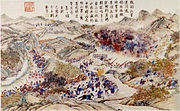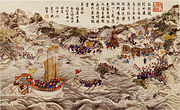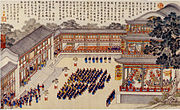Lin Shuangwen rebellion
| Pacification of Taiwan | |||||||
|---|---|---|---|---|---|---|---|
 The Qing fleet returning from Taiwan | |||||||
| |||||||
| Belligerents | |||||||
|
Qing Empire | Taiwanese rebels | ||||||
| Commanders and leaders | |||||||
|
| |||||||
| Strength | |||||||
|
3,000 police 10,000 troops sent to relieve Taiwan in 1786 20,000 troops brought by Fuk'anggan in 1788 including Green Standard Army and Eight Banners Quanzhou militia Hakka militia a minority of Zhangzhou militia | Zhangzhou militia (Minority of Quanzhou militia) | ||||||
| Casualties and losses | |||||||
| Unknown | Unknown | ||||||
The Lin Shuangwen rebellion (Chinese: 林爽文事件; Pe̍h-ōe-jī: Lîm Sóng-bûn sū-kiāⁿ; lit. 'Lin Shuangwen Incident') occurred in 1787–1788 in Taiwan under the rule of the Qing dynasty. The rebellion was started by the rebel Lin Shuangwen and was pacified by the Qianlong Emperor. Lin Shuangwen was then executed.[1]
It started when the Qing Taiwan governor Sun Jingsui (孙景燧) outlawed the Tiandihui society and arrested Lin Shuangwen's uncles. Lin then murdered Sun and formed an army to resist. Lin's forces which were mostly Zhangzhou people attacked several Taiwan sites, and fought militias mostly made out of Quanzhou and Hakka people, however some Quanzhou fought on Lin's side and some Zhangzhou people were on the Qing side. The Qing sent troops to quell the rebellion and execute Lin and the rebels.[2]
Events
Predecessors
Zhangzhou militias under Zhu Yigui rebelled against the Qing in 1721 and fought against militias mostly composed of Quanzhou and Hakka people.
Start of rebellion
Lin was an immigrant from Zhangzhou who came to Taiwan with his relatives in the 1770s. They were involved in the secret anti-Qing Tiandihui (Heaven and Earth Society). Intercenine fighting between Zhangzhou, Quanzhou and Hakka plagued the island.
In 1786, the Qing-appointed Governor of Taiwan,
On January 16, 1787, Lin murdered Sun Jingsui and other officials. The number of insurgents quickly rose to 50,000 people. By February, in less than a year, the rebels occupied almost all of southern Taiwan except for Zhuluo County and Lugangzhen (鹿港镇). They managed to push out some government forces out of Lin's home base in Changhua and Tamsui.
In response, Qing troops were sent to suppress them in a hurry. The eastern insurgents defeated the poorly organized troops and had to resist falling to the enemy. However, Lin's Zhangzhou forces fought against militias made out of mostly Quanzhou and Hakka people - who together made up approximately half of the Han migrants to Taiwan, with Lin's Zhangzhou people comprising the other half. Militias made out of majority Quanzhou and Hakka people cooperated with the Qing army to defeat Lin's armies.[3][4][5][6][7]
The Tiandihui rebels under Lin Shuangwen performed rituals like cockerel sacrifice.[8]
Quanzhou and Hakka
By this point, the fighting was drawing in Zhangzhou people beyond just the society members, and activating the old feuds; this brought out Quanzhou networks (as well as Hakka) on behalf of the government. Lin's forces were made mostly of Zhangzhou people, and the Zhangzhou and Quanzhou people were already feuding with each other, so the rebellion sparked a large-scale battle between the two sides. The Quanzhou faction formed their own army and cooperated with the Qing forces to resist Lin.
Zhangzhou militias also fought against Hakka militias. Hakka people from Taozhumiao (桃竹苗), Liudui (六堆), and other places organized a Taiwan Hakka volunteer army. The Hakka cooperated with the Qing army to defeat Lin's forces and defend their homes. Under the leadership of Chen Ziyun (陳紫雲), the Qing and Hakka forces battled in Hsinchu and other places.
Eventually, the government sent sufficient force to restore order. The governors of Zhejiang and Fujian then sent Fuzhou general Hengrui (恆瑞) and 4,000 troops to Taiwan to help quell the rebellion. After April 23, another 10,000 Qing troops were sent to Taiwan, and then another 7,000 were added.[3][4][5][6][7]
Qing reinforcements
Finally, in December 10, the Qing imperial court sent Fuk'anggan to quell the rebellion with a force of 20,000 soldiers, while Hailancha, Counsellor of the Police, deployed nearly 3,000 people to fight the insurgents with the majority from the Green Standard Army and a minority from the Eight Banners. These new troops were well equipped, disciplined and had combat experience which proved enough to route the insurgents.
The Qing annihilated Lin's army and captured Lin on February 10, 1788. As many as 300,000 took part in the rebellion. The Ming loyalists had lost the war, their leaders were executed, and the remaining rebels hid among the locals.[3][4][5][6][7]
Punishment
Lin Shuangwen was executed, and the Heaven and Earth Society was dispersed to
Imposing a penalty of castration upon the sons of rebels and murderers of 3 or more people was part of a new Qing policy to ensure a supply of young boy eunuchs since the Qianlong emperor ordered young eunuchs to be shifted towards the main imperial residence in the Summer Palace. Norman A. Kutcher connected the Qing policy on obtaining young eunuchs to the observation that young boy eunuchs were prized by female members of the Qing Imperial family as attendants, noted by the British George Carter Stent in the 19th century.[16][17] Norman Kutcher noted that George Stent said young eunuchs were physically attractive and were used for "impossible to describe" duties by female imperial family members and they were considered "completely pure". Kutcher suggests the boys were used for sexual pleasure by Qing imperial women, connecting them to the boy eunuchs called "earrings" who were used for that purpose.[12]
Sons of murderers above 15 were not beheaded unlike sons and grandsons of rebels and instead they were also castrated as eunuchs in the palace. The wives and daughters of murderers would be given to the murder victims' relatives if they still lived unlike wives and daughters of rebels. Qianlong and the Imperial Household Department under Heshen later decreed that sons of murderers who were 16 years old and older would be exiled as slaves to
Lin Shuangwen had some relatives like Lin Shi (Lin Shih) who founded the
Zhuang Datian had enlisted
During Qianlong's reign, Li Shiyao was involved in graft and embezzlement. Li Shiyao was demoted of his noble title and sentenced to death. However, after assisting in quelling the Lin Shuangwen rebellion, his life was spared.[4]
Aftermath
After the rebellion, local feuds between the Zhangzhou, Quanzhou, and Hakka people appeared only sporadically through the early 19th century, coming to an end in the 1860s. However, they never again were serious to push out the government or encompass the whole island. There were more than a hundred rebellions during the early Qing. The frequency of rebellions, riots, and civil strife in Qing Taiwan is evoked by the common saying "every three years an uprising; every five years a rebellion" (三年一反、五年一亂).[30]
In total, the Qing deployed fewer than 40,000 troops, and it took over one year to stamp the rebellion. However, through clever use of ethnic relations, forming good relations with the aborigines, and taking advantage of the feuds between the Taiwan internal factions (the Zhangzhou, Quanzhou migrants), the Qing successfully annihilated Lin's family and forces. In 1787, the Qianlong Emperor changed the name of Zhuluo County to Jiayi County (嘉義縣) to reward the Zhuluo people in helping resist and defeat Lin Shuangwen.[3][4][5][6][7]
Gallery
-
Battle of Dabulin
-
Attack on Douliumen (Zhuluo)
-
Conquest of Douliumen (Zhuluo)
-
Conquest of Dali
-
Attack on the mountain Xiaobantian
-
Battle of Kuzhai
-
Capture of the rebel chief Lin Shuangwen
-
Battle of Jijipu
-
Battle of Dawujing
-
Capture of Zhuang Datian
-
Crossing the ocean and triumphant return
-
Victory banquet of the emperor to greet the officers who attended the campaign against Taiwan.
See also
References
- OL 7734135M
- ^ "Qianlong Battle Prints" (PDF). Battle of Qurman - Painting from 1760 - Lost Fragment from ...
- ^ ISBN 978-0-520-92679-0.
- ^ a b c d e Hummel, Arthur W. Sr., ed. (1943). . Eminent Chinese of the Ch'ing Period. United States Government Printing Office.
- ^ a b c d "Archived copy". Archived from the original on 2016-08-11. Retrieved 2016-07-02.
{{cite web}}: CS1 maint: archived copy as title (link) - ^ a b c d "李永芳将军的简介 李永芳的后代-历史趣闻网". Archived from the original on 2017-12-03. Retrieved 2016-07-02.
- ^ a b c d "曹德全:首个投降后金的明将李永芳_[历史人物]_抚顺七千年-Wap版". Archived from the original on 2016-10-07. Retrieved 2016-06-30.
- ISBN 978-1134067879.
- ^ 莊吉發 (1992年). "《清代臺灣秘密會黨的發展與社會控制》" (PDF). 《人文及社會科學集刊》. 第5卷 (第1期). Archived (PDF) from the original on 2021-02-23. Retrieved 2020-07-23.
- JSTOR 4528897.
- ^ "QIANLONG BATTLE PRINTS" (PDF). Battle of Qurman - Painting from 1760 - Lost Fragment from ...
- ^ ISBN 978-0520969841.
- ISBN 978-9888455751.
- ^ 陈, 孔立. "1815 年台湾籍太监林表之死" (PDF). 25 周年学术研讨会论文. 厦门大学台湾研究院: 1, 2.
- ^ 林, 育德 (2014-06-05). 一個臺灣太監之死:清代男童集體閹割事件簿. 啟動文化.
- S2CID 159183602.
- ^ 柯, 启玄 (2017-02-22). "乾隆朝太监的短缺及其影响". 中国人民大学清史研究所. Archived from the original on 2019-06-22.
- ISBN 0-8203-1722-5.
- ISBN 978-1400886418.
- ^ Free China Review. 1983. p. 26.
The family pioneer , Lin Shih , settled in Changhua County . It was his son , Lin Chia - yin , who led the Lins to the estate's current site . The residence was later divided , and family members were quartered in an Upper House and a ...
- ^ Digest of Chinese Studies. Contributors American Association for Chinese Studies, Han xue yan jiu zhong xin. American Association for Chinese Studies. 1986. p. 25.
Due to the wealth of material he discovered , Mr. Huang finds that an exploration of the Lin family gives a microscopic ... yin , Lin Shih's grandson , re - established his family's enterprise , built up the family fortune , and laid a ...
{{cite book}}: CS1 maint: others (link) - ISBN 978-0765614940.
- ISBN 978-1317459088.
- ^ Han Cheung (15 May 2022). "Taiwan in Time: From village strongman to imperial commander". Taipei Times. Retrieved 15 May 2022.
- ISBN 978-1315288031.
- ISBN 978-9004483040.
- ^ Tu, Hsiao-Mei (2018). "〈舟車何遙遙──從平埔族人金娘一案觀解京之路〉A Long Journey: Investigating the Road to Capital by Reviewing the Case of Taiwanese Plains Indigenous Person Jin Niang". 故宮文物月刊.
- ^ 方, 格子 (2021-08-31). "台灣第一位女軍師是她!通曉方術、統領萬名反清勇士…揭歷史課本不提的抗清女英雄". 風傳媒.
- ISBN 978-9811074011.
- OL 979742M. p. 10












